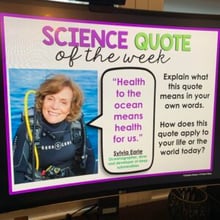Oceans Activities for Middle School Science
The resources below will provide students a comprehensive understanding of oceans. All of the following lessons are also included in the Kesler Science Membership.
The Oceans 5E Lesson includes materials for every "E" phase, including the Oceans Station Lab for Exploration and an interactive PowerPoint with digital INB templates for Explanation.
The lesson also includes introduction materials for Engagement, student-choice project ideas for Elaboration, and assessments for Evaluation.
After completing the Oceans 5E Lesson, students will be able to understand the oceans, ocean currents, the human impact on oceans, the composition of oceans, and how salinity, density and temperature are related.
The Oceans Inquiry Lab is a hands-on activity that is differentiated for advanced, on-level, and modified middle school students.
Students will explore the effects of salinity by creating three layers of salt water with different densities. Then, by boiling the top layer, they will see the effect
of evaporation on the density of the remaining water.
The Oceans Inquiry Lab includes a brief reading passage, comprehension checks, hands-on activities, reflection questions, and a CER conclusion.
Oceans Classroom Experiences
Create a powerful student experience to help solidify students' understanding about oceans. The following experience is also included in the Kesler Science Membership.
Escape Rooms
Lorem ipsum dolor sit amet, consectetur adipiscing elit. Duis porttitor, quam vel dignissim tincidunt, odio libero porta ligula, vitae fermentum lacus libero vel risus. Aenean pulvinar nisl et vestibulum commodo.
Quisque euismod tempus dignissim. Quisque dictum luctus velit, eu viverra urna tristique non. Vivamus at dolor tellus. Cras congue sapien non turpis dapibus, et vestibulum ante ultrices. Mauris eu nisi non sapien fermentum fermentum in eu odio. Fusce congue elit et tortor sagittis, sit amet auctor risus sagittis.
STEM CHALLENGES
The Save the Oceans STEM Challenge uses the engineering design process to prototype a machine to deal with the ocean's trash.
Students will be using collaborative skills such as brainstorming with their peers and reflecting on their progress during the project.
At the end of the Save the Oceans STEM challenge, students are given an opportunity to share their projects outside of the classroom.
Year-Round Resources
These year-round activities will increase your students' understanding of many middle school science topics. All of these activities are also included in the Kesler Science Membership.
Visual Data & Graphing
You're not alone if your students struggle with understanding graphs, charts, and tables. It's a skill that takes an enormous amount of practice. This resource will help students build a strong foundation in analyzing data and creating their own data visualizations.
Bell Ringers and Warm-Ups
These middle school science bell ringers are an excellent way to engage your students as soon as they walk into your classroom. This comprehensive FULL YEAR resource includes everything you need to start off each science class with an interesting warm-up activity.
Review Board Games
Each game board has been carefully designed to keep students engaged. There are 10 different action spaces on each board and dozens of question cards. All of the actions are related to science concepts and keep the students motivated throughout the game.
Each game is ready to play. Simply print out the board and the cards and let the students enjoy reviewing nine different units.
Essential Questions and Standards
Below are the essential questions and standards associated with the lessons and activities included in the oceans unit. This topic is only one of more than 100 middle school science topics included in the Kesler Science Membership.
-
What elements make up the ocean?
-
How are salinity, temperature, and density related?
-
How does the sun drive ocean currents?
-
What are some examples of seafloor structures and how are they mapped?
-
How are humans dependent on the ocean?
-
How have human activities modified the oceans?
-
MS ESS2-6 - Develop and use a model to describe how unequal heating and rotation of the Earth cause patterns of atmospheric and oceanic circulation that determine regional climates
-
TEKS Science 8.11 C - Recognize human dependence on ocean systems and explain how human activities such as runoff, artificial reefs, or use of resources have modified these systems
Kesler Science Membership
Imagine never having to search for another middle school science lesson again. The membership gives you access to ALL of the Kesler Science products in one place (Yes, including everything above).
Say goodbye to long hours of lesson prep.



